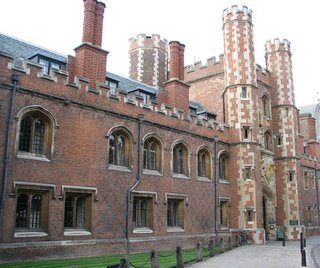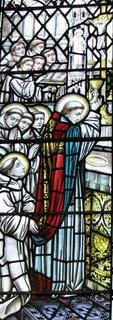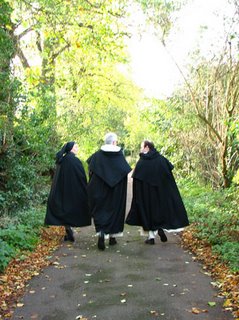The origins of Cambridge colleges
 We have already noted the origins of the university as a place of learning for clerical students. Unsurprisingly then, the colleges of Cambridge and Oxford, particularly the older and hence more picturesque foundations have their roots as religious houses.
We have already noted the origins of the university as a place of learning for clerical students. Unsurprisingly then, the colleges of Cambridge and Oxford, particularly the older and hence more picturesque foundations have their roots as religious houses.But colleges were not always a part of the university. Indeed in the Middle Ages, most students were not members of a college. As we saw yesterday, they may well have been members of a religious order and lived in the friary and travelled to lectures.
To acquire the status and privilege in law of being a student it was sufficient to find a Master of Arts who would put the name of a prospective student on his matricula, or list. This is the origin of the requirement of matriculation for entry into the university. As regards lodgings, some students (who were not members of a religious order) lived in the house of their Master, others rented lodgings from Cambridge townsfolk and others in hostels. Even then student life could be riotous, bawdy and even violent, fuelled by alcohol. Some things don't change!

In order to provide for a more disciplined and regular life more conducive to study, some benefactors founded colleges for students, which provided them with lodging, food and clothing. The first was Peterhouse founded in 1280 by the Bishop of Ely, followed by King Edward II in the 14th century. This gives us an idea of the sort of men who became college founders although Lady Margaret Beaufort and Elizabeth de Clare are aristocratic women who founded colleges. The Guild of Corpus Christi and the Guild of St Mary established Corpus Christi College and was famed for its annual Eucharistic procession. Many of these colleges were envisaged as places of prayer for the repose of the benefactors' souls and were endowed with many religious treasures. Corpus Christi, for example, owned no fewer than six chalices and a Monstrance of silver-gilt worth twenty pounds for use in its processions.
But not all students could be accommodated at these colleges in the Middle Ages and the colleges initially catered mainly to graduates. The colleges of Oxford and Cambridge were founded to unite in a common life groups of Masters and groups of students. College life brought them together to pray, either in a nearby parish church or in the chapel of the college, and to have their meals together in the college hall which could also be used for lectures and other gatherings. These medieval origins explain certain characteristics of Cambridge collegiate life which has endured such as the presence of a chapel with regular sung services and the importance of dining together in 'formal hall'.
The early colleges had what appears to be a monastic atmosphere because their members were all men and all celibate, as can be expected of clerical students. The Fellows were mostly priests and even when the law of clerical celibacy disappered in the Church of England after the Reformation, Fellows were not allowed to marry! This aspect of Cambridge life persisted until 1882. Another feature which reflects medieval usage is the grouping of rooms around a staircase with an open doorway at the bottom. There are no corridors such that residents have to cross the open courtyard to get from one part of the college to another.

As with so much else about England and its oldest traditions, glimpses of its Catholic past emerge if we scratch the surface. Walking the streets of this ancient university town, and walking through its cloisters and visiting its chapels, I cannot help but wonder what life in Catholic Cambridge would have been like and which streets the medieval Blackfriars traversed and where they prayed and preached.
I am indebted to Archbishop-Emeritus Couve de Murville and Philip Jenkins for much of the foregoing in this series on 'Catholic Cambridge' which is taken from their book of the same title (CTS, 1983) and all credit should go to them for these three articles.







1 Comments:
Fr Aidan Nichols OP is flanked by Sr Pauline Burling OP to left and Br Paul Mills OP to right.
Post a Comment
<< Home